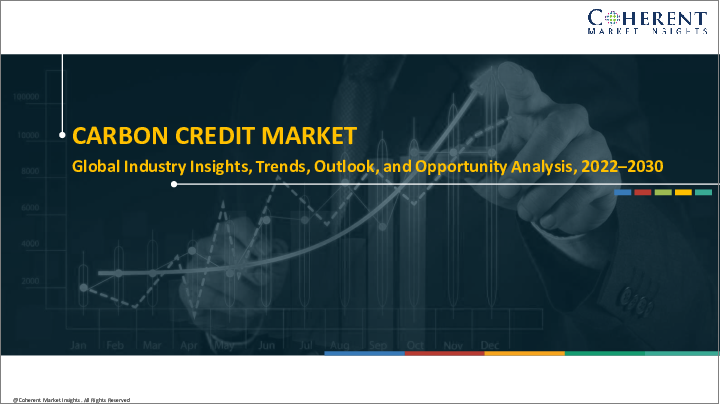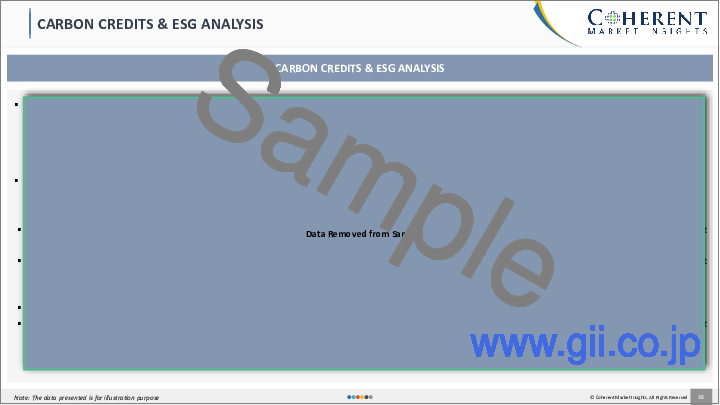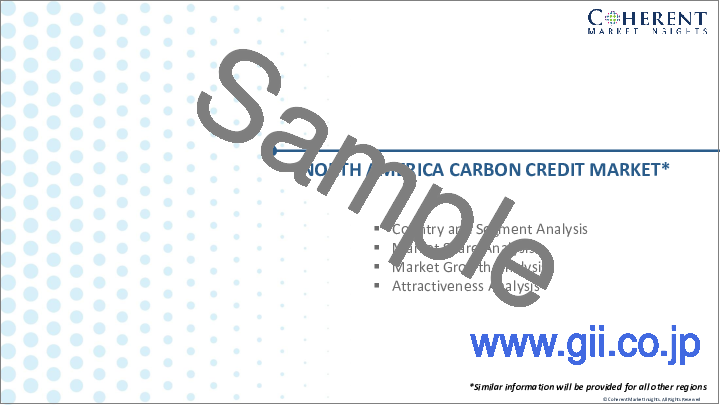|
|
市場調査レポート
商品コード
1290652
カーボンクレジット市場、セクター別、地域別、規模、シェア、展望、機会分析、2023年~2030年Carbon Credit Market, By Sector, By Region - Size, Share, Outlook, and Opportunity Analysis, 2023 - 2030 |
||||||
カスタマイズ可能
|
|||||||
| カーボンクレジット市場、セクター別、地域別、規模、シェア、展望、機会分析、2023年~2030年 |
|
出版日: 2023年05月10日
発行: Coherent Market Insights
ページ情報: 英文 150 Pages
納期: 2~3営業日
|
- 全表示
- 概要
- 目次
世界のカーボンクレジットは、二酸化炭素の排出を削減することが証明されているプロジェクトを直接支援することで、避けられない二酸化炭素排出のバランスをとる検証済みの方法をビジネスに提供します。1つのカーボンオフセット/クレジットは、1トンの二酸化炭素換算(CO2e)に相当する温室効果ガスの削減を表します。国連の気候変動に関する政府間パネル(IPCC)は、1997年に京都議定書として知られる協定で、世界の二酸化炭素排出量を削減するためのカーボンクレジット案を作成しました。京都議定書は、1997年に日本の京都で、先進国192カ国によって署名されました。京都議定書を批准した国には、CO2排出量の上限が設定されます。割り当てられた上限を超えて排出すると、違反した国には、次の期間の排出上限を下げるというペナルティが課されます。しかし、もしある国がその許容量以上の温室効果ガスを排出したい場合(ペナルティなし)、排出削減購入契約(ERPA)を使って炭素取引に参加することができます。
世界のカーボンクレジット市場は、供給者市場と購入者市場の2種類に分けられます。中国、インドなどの新興国(2015年のパリ協定により炭素排出の規制が緩和された)は、カーボンクレジット市場の世界の供給者と考えられています。インドは、世界のカーボンクレジット市場の新興プレーヤーの1つとなりつつありますが、インド企業のカーボンクレジット市場に対する認識不足が、インドのカーボンクレジット市場の成長を妨げると予想されます。インドの温室効果ガス排出量は炭素上限を下回っているため、インド企業は余剰クレジットを先進国に売却する権利を有しています。
市場力学
カーボンクレジット市場への投資の増加により、クレジット市場は予測期間中に大きく成長すると予想されます。現在、カーボンクレジット市場は、炭素排出とその規制に対応する企業にのみ限定されています。しかし、急速に成長する世界のカーボンクレジット市場は、ベンチャーキャピタルや銀行など様々な金融機関から資金を集めることが予想されます。一方、国際的な非営利団体も、スケーラブルな気候・環境対策に資金を提供し推進するために、カーボンクレジット市場に投資しています。.企業がネットゼロ目標に焦点を当て、二酸化炭素排出量の削減に取り組んでいることから、カーボンクレジットの需要は今後数十年で大きく伸びると思われます。カーボンクレジットは、二酸化炭素1トンに相当する温室効果ガスを排出する権利を表します。現在、いくつかの企業が、このカーボンクレジットを部分的に利用する手法を採用しており、大きな利益を得ています。彼らは、オフセットを生み出すためのプロジェクトや活動に参加しています。プロジェクトに設定された上限に従って、必要なだけのクレジットを使用し、残りがあれば、後で別のプロジェクトに使用します。これにより、大幅なコスト削減が可能になるだけでなく、より多くのクレジットを投資することができるようになります。
林業分野は、予測期間中に最も高い成長を示すと予想されています。森林は気候変動に対抗する上で重要な役割を担っています。熱帯林は世界の地表の約15%を占め、地表の炭素の約25%を含んでいます。森林の消失と劣化は、世界の炭素排出量の15~20パーセントを占めています。これらの排出量の大部分は、熱帯地方における森林減少の結果であり、その主な原因は、農業や鉱業など、より有利な経済活動への森林の転換にあります。森林カーボンクレジットの市場は、過去10年間で大きく成長しました。現在、カーボンオフセットの対象となるプロジェクトは、植林・再植林、転換回避、森林管理改善(IFM)の3種類に分類されます。改良型森林管理プロジェクトは、カリフォルニア州のキャップ・アンド・トレード・プログラムで取引される最も一般的なコンプライアンス・オフセットです。
本調査の主な特徴
本レポートでは、2022年を基準年とした予測期間(2023年~2030年)における世界のカーボンクレジット市場規模(Mn US$Billion)および複合年間成長率(CAGR %)を詳細に分析し
- さまざまなセグメントにおける潜在的な収益機会を解明し、この市場に対する魅力的な投資提案のマトリックスについて説明しています。
- また、市場促進要因、抑制要因、機会、新製品の発売や承認、地域の展望、主要な市場プレーヤーが採用する競合戦略に関する重要な考察を提供します。
- 企業概要、業績、製品ポートフォリオ、地域的存在感、市場開拓、主要な発展、戦略、将来計画など、以下のパラメータに基づいて世界のカーボンクレジット市場の主要企業をプロファイルしています。
- 本調査の対象となる企業には、WGL Holdings, Inc., Enking International, Green Mountain Energy, Native Energy, Cool Effect, Inc., Clear Sky Climate Solutions, Sustainable Travel International, 3 Degrees, terrapass, and Sterling Planet, Inc.が含まれます。
- 本レポートの洞察により、企業のマーケティング担当者や管理当局は、将来の製品発売、製品アップグレード、市場拡大、マーケティング戦術に関する情報に基づいた意思決定を行うことができます。
- 本レポートは、投資家、サプライヤー、マネージドサービスプロバイダー、第三者サービスプロバイダー、販売業者、新規参入者、付加価値再販業者など、この業界のさまざまな利害関係者に対応しています。
- 利害関係者は、世界のカーボンクレジット市場の分析に使用される様々な戦略マトリックスを通じて、意思決定を容易にすることができます。
目次
第1章 調査目的と前提条件
- 調査目的
- 前提条件
- 略語
第2章 市場展望
- レポート概要
- 市場の定義と範囲
- エグゼクティブサマリー
- コヒーレント・オポチュニティ・マップ(COM)
第3章 市場力学、規制、動向分析
- 市場力学
- 促進要因
- 抑制要因
- 市場機会
- 規制のシナリオ
- 業界動向
- 合併・買収
- 排出権取引の手順
- 企業が購入するカーボンクレジット(オフセット
- カーボンオフセットのプロセス
- 世界の温室効果ガス排出量の概要
- 国別一人当たり炭素排出量データ(2019年版)
- 国別イニシアティブの概要
- カーボンクレジット市場プロトコルと基準
- カーボンクレジットメカニズム
- カーボン価格の概要
- COVID-19パンデミックの影響
第4章 世界のカーボンクレジット市場、セクター別、2017-2030年
- エネルギー
- 運輸
- 住宅および商業ビル
- 産業分野
- 農業
- 林業
- 上水道・下水道
- その他
第5章 カーボンクレジットの世界市場、地域別、2017-2030年
- 北米
- 米国
- カナダ
- 欧州
- 英国
- ドイツ
- フランス
- ロシア
- その他欧州
- アジア太平洋地域
- 中国
- インド
- 日本
- ASEAN
- オーストラリア
- 韓国
- その他アジア太平洋地域
- ラテンアメリカ
- ブラジル
- アルゼンチン
- メキシコ
- その他ラテンアメリカ地域
- 中東・アフリカ
- 南アフリカ
- GCC諸国
- その他中東とアフリカ
第6章 競合情勢
- 企業プロファイル
- WGL Holdings, Inc.
- Enking International
- Green Mountain Energy
- Native Energy
- Cool Effect, Inc.
- Clear Sky Climate Solutions
- Sustainable Travel International
- 3 Degrees
- terrapass
- Sterling Planet, Inc.
第7章 セクション
- 参考文献
- 調査手法
The global carbon credits provide business with a verified method to balance unavoidable carbon footprint by directly supporting projects that are proven to reduce carbon emissions. One Carbon Offset/Credit represents the reduction of greenhouse gases equal to one metric ton of carbon dioxide equivalent (CO2e). The United Nations' Intergovernmental Panel on Climate Change (IPCC) developed a carbon credit proposal to reduce worldwide carbon emissions in a 1997 agreement known as the Kyoto Protocol. The Kyoto Protocol was signed in Kyoto, Japan, in 1997 by 192 industrialized countries. Countries that ratify the Kyoto Protocol are assigned a maximum limit of CO2 emission levels. Emitting more than the assigned limit will result in a penalty for the violating country in the form of lower emissions limit for the following period. However, if a country wants to emit more greenhouse gases than its allowed limit (without penalty), then it may participate in carbon trading using an Emissions Reduction Purchase Agreement (ERPA).
The global carbon credit market is divided into two types, suppliers market and buyers' market. The emerging economies such as China, India, and others (with relaxed rules for carbon emission as per Paris agreement in 2015) are considered as global suppliers for carbon credit market. India is becoming one of the emerging players for global carbon credit market, however, lack of awareness about carbon credit market among the Indian companies is expected to hamper the Indian carbon credit market growth. As India's GHG emission is below the carbon cap limit, Indian companies are entitled to sell surplus credits to developed countries.
Market Dynamics
Credit market is expected to grow significantly during the forecast period, owing to the increasing investment in the carbon credit market. At present, the carbon credit market is only limited to companies that are dealing with carbon emissions and its regulations. However, the rapidly growing global carbon credit market is expected to attract funding from various financial institutions such as venture capitals, banks, and others. On the other hand, international non-profit organizations are also investing in the carbon credit market in order to fund and promote scalable climate and environmental actions. . The demand for carbon credits will significantly grow in the coming decades as the companies are focused on net zero targets and are working toward reducing carbon emissions. A carbon credit represents the right to emit greenhouse gases equivalent to one ton of carbon dioxide. Several businesses are now adopting this technique of partially using carbon credits, which is benefitting them significantly. They are getting involved in projects and activities that are helping them generate offsets. They use as many credits as they want according to the limit set for a project and if they have a few left, they are used later for another project. This not only helps them save a significant amount of money, which can aid them in investing in more such credits.
Among sector, forestry segment is expected to exhibit the highest growth during the forecast period. Forests play a vital role in combating climate change. Tropical forests cover about 15 percent of the world's land surface and contain about 25 percent of the carbon on the planet's surface. The loss and degradation of forests accounts for 15 - 20 percent of global carbon emissions. The majority of these emissions are the result of deforestation in the tropics, largely due to conversion of the forest to more lucrative economic activities such as agriculture and mining. The market for forest carbon credits has been significantly growing over the past ten years. Currently, there are three different project types that are eligible to produce carbon offsets; afforestation or reforestation, avoided conversion, and improved forest management (IFM). Improved forest management projects are the most common compliance offsets traded in California's cap and trade program.
Key features of the study:
This report provides in-depth analysis of global carbon credit market size (Mn US$ Billion) and compound annual growth rate (CAGR %) for the forecast period (2023- 2030), considering 2022 as the base year
- It elucidates potential revenue opportunities across different segments and explains attractive investment proposition matrices for this market
- This study also provides key insights about market drivers, restraints, opportunities, new product launches or approvals, regional outlook, and competitive strategies adopted by the leading market players
- It profiles leading players in the global carbon credit market based on the following parameters - company overview, financial performance, product portfolio, geographical presence, market capital, key developments, strategies, and future plans
- Companies covered as a part of this study include WGL Holdings, Inc., Enking International, Green Mountain Energy, Native Energy, Cool Effect, Inc., Clear Sky Climate Solutions, Sustainable Travel International, 3 Degrees, terrapass, and Sterling Planet, Inc.
- Insights from this report would allow marketers and management authorities of companies to make informed decisions regarding future product launches, product upgrades, market expansion, and marketing tactics
- The global carbon credit market report caters to various stakeholders in this industry including investors, suppliers, managed service providers, third-party service providers, distributors, new entrants, and value-added resellers
- Stakeholders would have ease in decision-making through various strategy matrices used in analysing the global carbon credit market
Detailed Segmentation
- Global Carbon Credit Market, By Sector:
- Energy
- Transportation
- Residential and Commercial Buildings
- Industry
- Agriculture
- Forestry
- Water and Wastewater
- Global Carbon Credit Market, By Region:
- North America
- By Country:
- U.S.
- Canada
- Asia Pacific
- By Country:
- China
- India
- Japan
- Australia
- South Korea
- ASEAN
- Rest of Asia Pacific
- Europe
- By Country:
- Germany
- Italy
- U.K.
- France
- Russia
- Rest of Europe
- Latin America
- By Country:
- Brazil
- Mexico
- Argentina
- Rest of Latin America
- Middle East and Africa
- By Country/Region:
- GCC Countries
- South Africa
- Rest of Middle East and Africa
- North America
- Company Profiles
- WGL Holdings, Inc.*
- Company Overview
- Product Portfolio
- Financial Performance
- Key Strategies
- Recent Developments/ Updates
- Enking International
- Green Mountain Energy
- Native Energy
- Cool Effect
- Clear Sky Climate Solutions
- Sustainable Travel International
- 3 Degrees
- terrapass
- Sterling Planet, Inc.
- WGL Holdings, Inc.*
"*" marked represents similar segmentation in other categories in the respective section.
Table of Contents
1. Research Objectives and Assumptions
- Research Objectives
- Assumptions
- Abbreviations
2. Market Purview
- Report Description
- Market Definition and Scope
- Executive Summary
- Market Snippet, By Sector
- Market Snippet, By Region
- Coherent Opportunity Map (COM)
3. Market Dynamics, Regulations, and Trends Analysis
- Market Dynamics
- Drivers
- Restraints
- Market Opportunities
- Regulatory Scenario
- Industry Trend
- Merger and Acquisitions
- Procedure Of Carbon Credit Trading
- Carbon Credit (Offset) Purchased By Companies
- Carbon Offsetting Process
- Global Greenhouse Gas Emissions Overview
- Per Capita Carbon Emissions Data By Country (2019)
- Overview Of Initiatives By Country
- Carbon credit market: Protocols and standards
- Carbon Crediting Mechanisms
- Carbon Pricing Overview
- Impact of the COVID-19 Pandemic
4. Global Carbon Credit Market, By Sector, 2017-2030 (US$ Million)
- Introduction
- Market Share Analysis, 2017 and 2030 (%)
- Segment Trends
- Energy
- Introduction
- Market Size and Forecast, 2017-2030, (US$ )
- Transportation
- Introduction
- Market Size and Forecast, 2017-2030, (US$ )
- Residential and Commercial Buildings
- Introduction
- Market Size and Forecast, 2017-2030, (US$ )
- Industry
- Introduction
- Market Size and Forecast, 2017-2030, (US$ )
- Agriculture
- Introduction
- Market Size and Forecast, 2017-2030, (US$ )
- Forestry
- Introduction
- Market Size and Forecast, 2017-2030, (US$ )
- Water and Wastewater
- Introduction
- Market Size and Forecast, 2017-2030, (US$ )
- Others
- Introduction
- Market Size and Forecast, 2017-2030, (US$ )
5. Global Carbon Credit Market, By Region, 2017-2030 (US$ )
- Introduction
- Market Share Analysis, By Region, 2017 and 2030 (%)
- North America
- Regional Trends
- Market Size and Forecast, By Sector, 2017-2030 (US$ )
- Market Share Analysis, By Country, 2017 and 2030 (%)
- U.S.
- Canada
- Europe
- Regional Trends
- Market Size and Forecast, By Sector, 2017-2030 (US$ )
- Market Share Analysis, By Country, 2017 and 2030 (%)
- U.K.
- Germany
- France
- Russia
- Rest of Europe
- Asia Pacific
- Regional Trends
- Market Size and Forecast, By Sector, 2017-2030 (US$ )
- Market Share Analysis, By Country, 2017 and 2030 (%)
- China
- India
- Japan
- ASEAN
- Australia
- South Korea
- Rest of Asia Pacific
- Latin America
- Regional Trends
- Market Size and Forecast, By Sector, 2017-2030 (US$ )
- Market Share Analysis, By Country, 2017 and 2030 (%)
- Brazil
- Argentina
- Mexico
- Rest of Latin America
- Middle East and Africa
- Regional Trends
- Market Size and Forecast, By Sector, 2017-2030 (US$ )
- Market Share Analysis, By Country/Region, 2023 and 2030 (%)
- South Africa
- GCC Countries
- Rest of the Middle East and Africa
6. Competitive Landscape
- Company Profiles
- WGL Holdings, Inc.
- Company Overview
- Product Portfolio
- Financial Performance
- Key Strategies
- Recent Developments/Updates
- Enking International
- Company Overview
- Product Portfolio
- Financial Performance
- Key Strategies
- Recent Developments/Updates
- Green Mountain Energy
- Company Overview
- Product Portfolio
- Financial Performance
- Key Strategies
- Recent Developments/Updates
- Native Energy
- Company Overview
- Product Portfolio
- Financial Performance
- Key Strategies
- Recent Developments/Updates
- Cool Effect, Inc.
- Company Overview
- Product Portfolio
- Financial Performance
- Key Strategies
- Recent Developments/Updates
- Clear Sky Climate Solutions
- Company Overview
- Product Portfolio
- Financial Performance
- Key Strategies
- Recent Developments/Updates
- Sustainable Travel International
- Company Overview
- Product Portfolio
- Financial Performance
- Key Strategies
- Recent Developments/Updates
- 3 Degrees
- Company Overview
- Product Portfolio
- Financial Performance
- Key Strategies
- Recent Developments/Updates
- terrapass
- Company Overview
- Product Portfolio
- Financial Performance
- Key Strategies
- Recent Developments/Updates
- Sterling Planet, Inc.
- Company Overview
- Product Portfolio
- Financial Performance
- Key Strategies
- Recent Developments/Updates
- Analyst Views
7. Section
- References
- Research Methodology
- About us and Sales Contact





